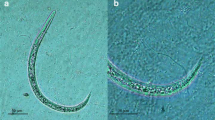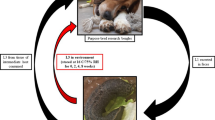Abstract
Experimental infection with Angiostrongylus vasorum was conducted in Iberian slugs Arion lusitanicus. Initially, different size/age groups of juvenile slugs (small, <0.5 g and medium, 0.5–1 g) were exposed to freshly isolated first-stage parasitic larvae (L1) of A. vasorum. The slugs were subsequently incubated at 5, 10 and 15°C for 6 weeks. Larval development within the slugs differed significantly with temperature. At 15°C, all larvae developed into the third larval stage (L3), at 10°C into the second stage (L2), whereas no development was observed at 5°C. The mean larval burdens were highest in the largest group of slugs and tended to increase with higher temperature. In a second experiment isolated L1 were incubated at 5, 10 and 15°C for 3 and 7 days prior to infection of slugs, which then were kept for 6 weeks at 15°C. The infectivity decreased significantly with the larval storage time and the mean larval burden per slug was lower at higher incubating temperature. However, all established larvae developed into infective L3. Temperature had an effect on the development of the larvae and thus an impact on transmission of the parasite as only L3 are infective to the definitive canid hosts.


Similar content being viewed by others
References
Ash LR (1970) Diagnostic morphology of the third-stage larvae of Angiostrongylus cantonensis, Angiostrongylus vasorum, Aelurostrongylus abstrusus and Anafilaroides rostratus (Nematoda: Metastongyloidea). J Parasitol 56:249–253
Bolt G, Monrad J, Henriksen P, Dietz HH, Koch J, Bindseil E, Jensen AL (1992) The fox (Vulpes vulpes) as a reservoir for canine angiostrongylosis in Denmark. Field survey and experimental infections. Acta Vet Scand 33:357–362
Conejo ME, Morera P (1988) Influence of the age of Veronicellid slugs in Angiostrongylus costaricensis infection. Rev Biol Trop 36:519–526, Abstract in English
Ferdushy T, Kapel CMO, Webster P, Al-Sabi MNS, Grønvold J (2009) The occurrence of Angiostrongylus vasorum in terrestrial slugs from forests and parks in the Copenhagen area, Denmark. J Helminthol 83:379–383
Guilhon J, Cens B (1973) Angiostrongylus vasorum (Baillet, 1866) Etude biologique et morphologoque. (Angiostrongylus vasorum (Baillet, 1866). Morphological and biological study). Ann Parasit Hum Comp 48:567–596, Abstract in English
Halvorsen O, Skorping A (1982) The influence of temperature on growth and development of the nematode Elaphostrongylus rangiferi in the gastropods Arianta arbustorum and Euconulus fulvus. OIKOS 38:285–290
Hardon T (2001) Den Stænk tætte Baermann undersøgelse (The splash- proof Baermann examintaion). Dansk Veterinaer Tidsskrift (Danish Veterinary Journal), nr.2 [Available online 2/23/2008], URL: http:dddweb.ddd.dk/pages/artikel.asp/Id=242
Hori E, Yamaguchi K, Fujimoto K, Nishina M, Takahashi M (1985) Experimental studies on the development of Angiostrongylus cantonensis in mollusks: development under low temperatures. Jpn J Parasitol 34:272–284, Abstract in English
Ibrahim MM (2007) Prevalence and intensity of Angiostrongylus cantonensis in freshwater snails in relation to some ecological and biological factors. Parasite- J Soc Fr Parasitol 14:61–70
Ishii AI (1984) Effects of temperature on the larval development of Angiostrongylus cantonensis in the intermediate host, Biomphalaria glabrata. Parasitol Res 70:375–379
Kozlowski J (2007) The distribution, biology, population dynamics and harmfulness of Arion lusitanicus Mabile, 1868 (Gastropoda: Pulmonata:Arionidae) in Poland. J Plant Protection Res 47:219–230
Rosen L, Ash LR, Wallace GD (1970) Life history of the canine lung worm Angiostrongylus vasorum (Baillet). Am J Vet Res 31:131–143
Shan LV, Zhou XN, Zhang Y, Liu HX, Zhu D, Yin WG, Steinmann P, Wang XH, Jia TW (2006) The effect of temperature on the development of Angiostrongylus cantonensis (Chen 1935) in Pomacea canaliculata (Lamarck 1822). Parasitol Res 99:583–587
Skorping A (1982) Elaphostrongylus rangeferi: influences of temperature, substrate, and larval age on the infection rate in the intermediate snail host, Arianta arbustorum. Expl Parasitol 54:222–228
Skorping A (1985) Lymnea stagnalis as experimental intermediate host for the protostrongylid nematode Elaphostrongylus rangeferi. Parasitol Res 71:265–270
Wallace GD, Rosen L (1969) Experimental infection of Pacific Islands molluscs with Angiostrongylus cantonensis. Am J Trop Med Hyg 18:13–19
Yousif F, Lammer G (1975) The effect of some biological and physical factors on infection of Biomphalaria glabrata with Angiostrongylus cantonensis. Parasitol Res 47:191–201
Acknowledgement
Hanne Rawat is acknowledged for her competent technical support.
Author information
Authors and Affiliations
Corresponding author
Rights and permissions
About this article
Cite this article
Ferdushy, T., Kapel, C.M.O., Webster, P. et al. The effect of temperature and host age on the infectivity and development of Angiostrongylus vasorum in the slug Arion lusitanicus . Parasitol Res 107, 147–151 (2010). https://doi.org/10.1007/s00436-010-1850-x
Received:
Accepted:
Published:
Issue Date:
DOI: https://doi.org/10.1007/s00436-010-1850-x




